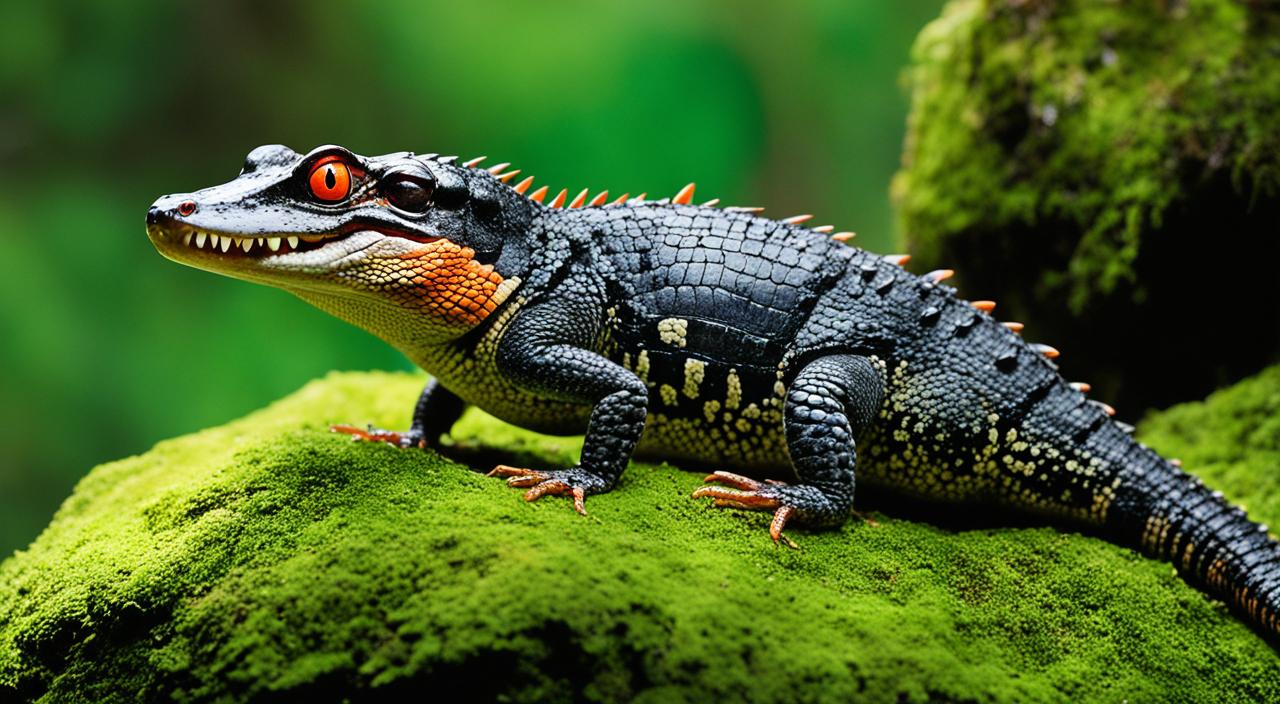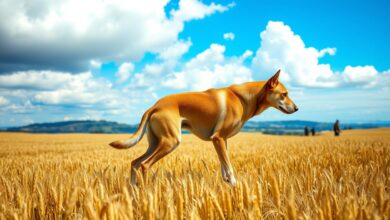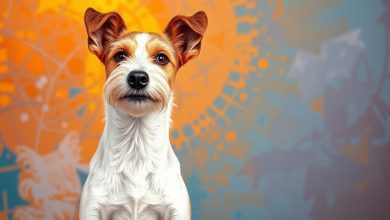Imagine owning a miniature dragon! The red-eyed crocodile skink (Tribolonotus gracilis) comes close to this fantasy. This exotic lizard has gained popularity since 1994. Its striking looks and fascinating behavior make it a captivating pet.
Red-eyed crocodile skinks, or “Tribbies,” hail from New Guinea and Indonesia’s tropical forests. They scurry across forest floors and climb branches in search of food. These small reptiles are known for their unique features.
“Tribbies” are considered intermediate-level pets in the reptile-keeping world. They have specific care needs that require some experience. If you’re up for a challenge, these lizards can be rewarding companions.
This guide will explore the origins and characteristics of red-eyed crocodile skinks. We’ll also cover their care needs. By the end, you’ll know if a “Tribbie” is right for you.
Introduction to the Red-Eyed Crocodile Skink
Red-eyed crocodile skinks are fascinating lizards that captivate reptile enthusiasts. Their striking looks and intriguing behaviors make them popular exotic pets. These unique skinks boast remarkable features that set them apart.
Scientific Name and Origins
The red-eyed crocodile skink’s scientific name is Tribolonotus gracilis. “Gracilis” means “small” or “lanky” in Latin, describing their slender build. These skinks hail from New Guinea’s tropical rainforests and Indonesia’s Admiralty Islands.
Their native habitats offer warm, humid conditions with lush vegetation. This environment perfectly suits the needs of these unique lizards.
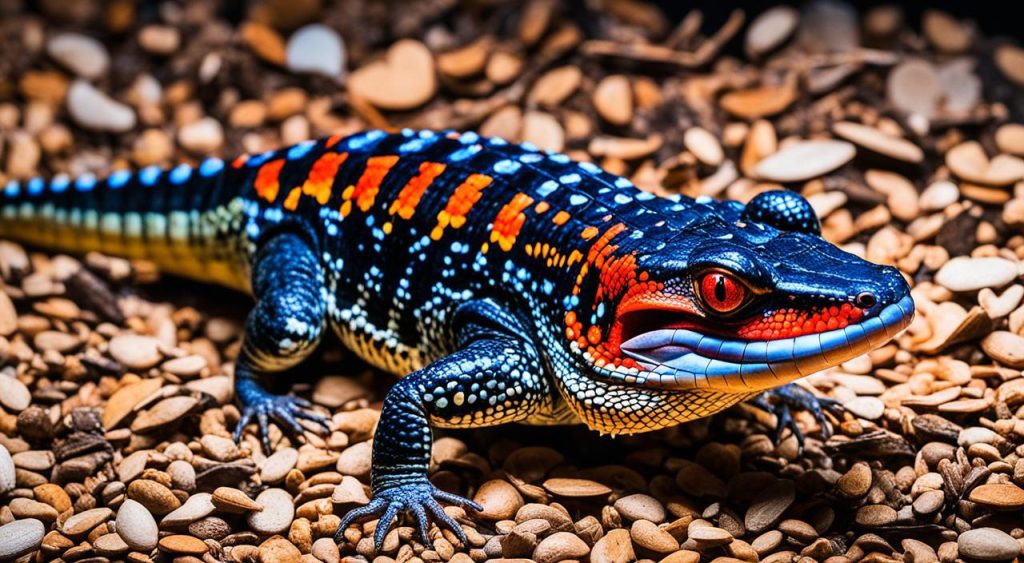
Physical Characteristics and Unique Features
Red-eyed crocodile skinks have distinct physical traits. Their most striking feature is bright orange or red scales around black eyes. This vibrant coloration gives them their common name.
These lizards sport armor-like scales on their backs, resembling crocodiles. This feature protects them from predators. Adult skinks typically have brown or black dorsal sides with yellow or cream undersides.
| Characteristic | Description |
|---|---|
| Average Adult Size | 7-9 inches |
| Lifespan | 10-14 years |
| Eye Coloration | Bright orange or reddish scales surrounding black eyes |
| Dorsal Scales | Armor-like, resembling crocodile scales |
| Body Coloration | Uniform brown or black on the dorsal side, yellow or cream-colored undersides |
Red-eyed crocodile skinks are small, growing to 7-9 inches as adults. With proper care, they can live 10-14 years. This makes them a long-term commitment for pet owners.
Natural Habitat and Behavior
Red-eyed crocodile skinks live in New Guinea and Indonesia’s tropical rainforests. They hide and hunt on forest floors. These lizards have adapted to changing landscapes, finding shelter in coconut plantations.
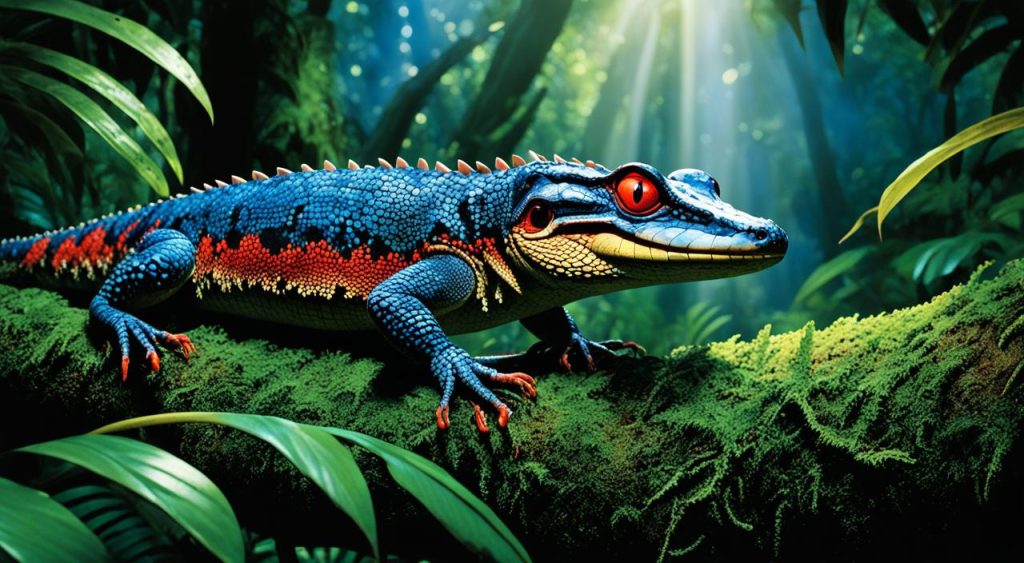
Native Range and Habitat Preferences
These skinks live under forest debris near water sources. Their habitat has daytime highs of 81°F (27°C) and nighttime lows of 73°F (23°C). The humidity stays above 70% year-round.
Red-eyed crocodile skinks are skilled climbers. This helps them survive in their complex habitat. It’s crucial as they face deforestation and human encroachment.
Activity Patterns and Social Behavior
These lizards are most active at dawn and dusk. They hunt for insects, small worms, and grubs during these times. Red-eyed crocodile skinks are solitary, except during breeding season.
When threatened, they make unique sounds. Males and females have different vocalizations. Their breeding behavior is still a mystery due to their secretive nature.
| Characteristic | Description |
|---|---|
| Native Range | Tropical rainforests of New Guinea and Indonesia |
| Habitat Preferences | Forest floors, under debris, near water sources |
| Activity Patterns | Crepuscular (active at dawn and dusk) |
| Social Behavior | Solitary, except during breeding season |
| Diet | Insects, small worms, and grubs |
| Vocalizations | Capable of producing sounds, differs between sexes |
Knowing these skinks’ natural habitat is key for proper captive care. Mimic their native environment and respect their habits. This ensures these fascinating lizards thrive in captivity.
Housing Requirements for Pet Red-Eyed Crocodile Skinks
Pet red-eyed crocodile skinks need a habitat like their natural home. These lizards thrive in specific conditions. A proper enclosure, substrate, temperature, and humidity are crucial.
Enclosure Size and Type
Adult skinks need a 30x12x12 inch terrarium or 20-gallon long tank. Bigger is better for exploration and temperature control. Use a horizontal tank with a mesh lid for ventilation.
These skinks are ground-dwellers. They need space to move around comfortably. Proper air flow helps maintain humidity levels.
Substrate and Decorations
Red-eyed crocodile skinks love to burrow. Use a mix of coconut fiber, cypress mulch, and sphagnum bark. Make it 2-3 inches deep for digging.
Add plants, rocks, logs, and bark strips for hiding and climbing. Don’t overcrowd the tank. Leave room for movement and easy cleaning.
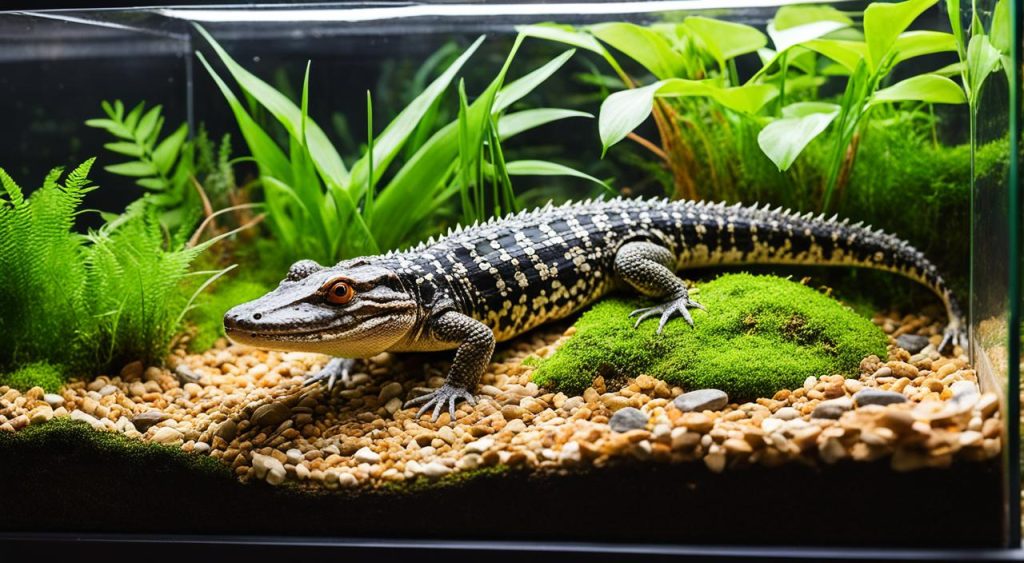
Temperature and Humidity Control
Proper temperature and humidity are vital for skink health. Keep the basking spot at 82-89°F (28-32°C). The cool zone should be 72-78°F (22-26°C).
Use a heat lamp or ceramic emitter on one side. This lets your skink move between warm and cool areas. Never let it drop below 70°F (21°C).
Maintain 70-95% humidity, ideally 80-90%. Mist the enclosure 2-3 times daily. Provide a large, shallow water dish for drinking and soaking.
Keep the substrate moist but not soggy. Good ventilation prevents stagnant air and harmful growth. Monitor and adjust conditions regularly.
| Enclosure Parameter | Recommended Range |
|---|---|
| Size (single adult) | 30″L x 12″W x 12″H or 20-gallon long tank |
| Basking Temperature | 82-89°F (28-32°C) |
| Cool Zone Temperature | 72-78°F (22-26°C) |
| Humidity | 70-95%, ideally 80-90% |
A well-designed enclosure with the proper substrate, temperature gradient, and humidity levels is the foundation for a healthy and happy red-eyed crocodile skink.
A good enclosure ensures your skink stays healthy for years. Monitor temperature and humidity often. Adjust as needed for your lizard’s comfort.
Lighting and Heating Needs
Proper lighting and heating are vital for red-eyed crocodile skinks. These lizards need specific temperatures and UVB exposure to stay healthy. Your skink’s well-being depends on meeting these requirements.
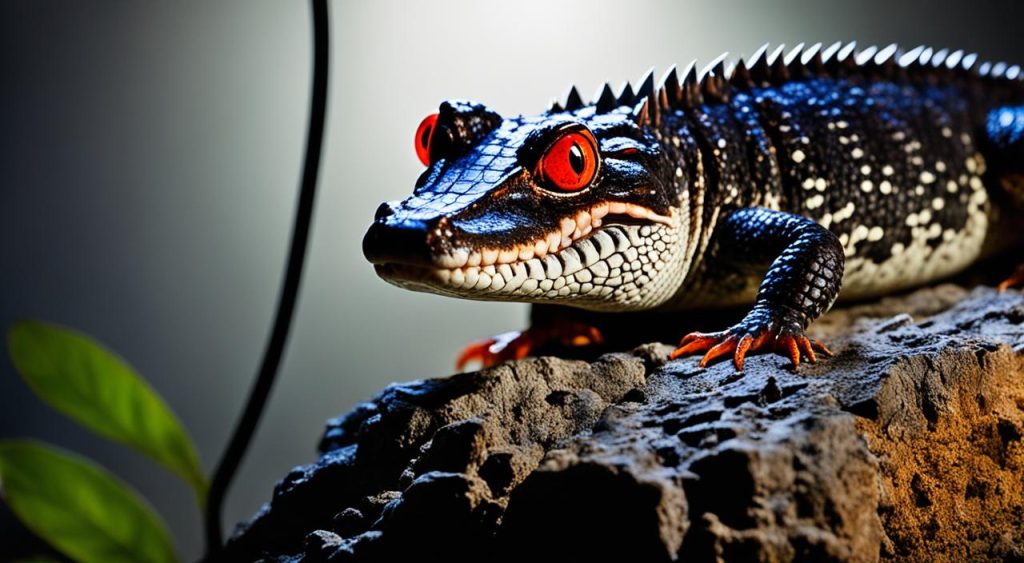
Use a 6% T5 UVB bulb or Arcadia ShadeDweller for UVB lighting. Maintain a UV index of 1-2. Replace the bulb every 6-12 months for best results.
Create a basking spot for your skink to control its body temperature. Use a halogen bulb or ceramic heat emitter with a thermostat. Keep basking temperatures between 32-34°C (90-93°F).
A popular choice among red-eyed crocodile skink keepers is a 15w halogen bulb for providing a suitable basking spot.
Provide a temperature gradient in the enclosure. Keep the cool side around 24°C (75°F). This lets your skink move between different temperature zones as needed.
| Parameter | Requirement |
|---|---|
| UVB Lighting | 1-2 UVI (6% T5 or ShadeDweller) |
| Basking Temperature | 32-34°C (90-93°F) |
| Cool Side Temperature | 24°C (75°F) |
| Heating | Halogen bulb or ceramic heat emitter |
Add hiding spots and decorations on both warm and cool sides. This helps your skink feel secure. It also allows them to adjust their heat and UVB exposure.
Feeding and Diet
Red-eyed crocodile skinks eat live insects. A varied diet is crucial for their health in captivity. Proper nutrition keeps these fascinating creatures thriving.
Suitable Prey Items
Offer a diverse selection of live food to your skink. This ensures a balanced diet. Some good options include:
- Crickets
- Dubia roaches
- Mealworms
- Superworms
- Waxworms
- Earthworms
- Hornworms
Feed prey no larger than half your skink’s head size. Use a separate dish for food. Remove uneaten insects after feeding.
Supplements and Gut Loading
Dust live food with calcium powder containing vitamin D3. Juveniles need daily dusting, adults every other day. Provide a multivitamin supplement weekly.
Gut-load insects 24-48 hours before feeding. This boosts their nutritional value. Use dark leafy greens, carrots, or commercial gut-loading formulas.
Feeding Schedule for Juveniles and Adults
Young skinks need daily feeding due to higher energy needs. Adult feeding schedules differ:
| Age | Feeding Frequency |
|---|---|
| Juveniles (under 1 year) | Daily |
| Adults (over 1 year) | Every other day, with 1-2 starve days per week |
A proper feeding schedule prevents obesity. Monitor your skink’s body condition regularly. Adjust feeding as needed to maintain a healthy weight.
“A varied and well-supplemented diet is key to ensuring the long-term health and happiness of your red-eyed crocodile skink.”
Offer diverse, gut-loaded, and supplemented live food. This meets your skink’s nutritional needs. It supports their growth and development effectively.
Handling and Interaction with Red-Eyed Crocodile Skinks
Red-eyed crocodile skinks are unique lizard pets with special needs. They’re shy and prefer to avoid human contact. Too much handling can stress them out and cause health problems.
Temperament and Stress Response
These skinks are easily scared and stressed when handled. When frightened, they might freeze up or play dead. It’s vital to respect their space and handle them as little as possible.
Female skinks can be more protective after laying eggs. It’s crucial to give them space and not disturb their nests. A well-designed enclosure with hiding spots can help reduce their stress.
Tips for Safe and Minimal Handling
Sometimes you’ll need to handle your skink for health checks or cage cleaning. Here are some tips to keep your skink safe and calm:
- Always approach your skink calmly and slowly to avoid startling them.
- Use gentle, controlled movements when handling to minimize stress.
- Support your skink’s body fully, allowing them to feel secure.
- Avoid chasing or grabbing your skink, as they are fast runners and may attempt to escape.
- Keep handling sessions brief, no more than a few minutes at a time.
- Wash your hands before and after handling to prevent the spread of bacteria or parasites.
Understanding your skink’s needs is key to their health and happiness. Give them a good home, proper food, and minimal handling. This will help your unique lizard friend thrive under your care.
Common Health Concerns
Red-eyed crocodile skinks can face health issues if their care needs aren’t met. Owners should know potential problems and take steps to prevent them. Let’s explore three common health concerns for these scaly pets.
Gastrointestinal Issues
Gastrointestinal disease often shows up as runny stools, appetite loss, and weight loss in skinks. Causes include bacterial infections, parasites, or poor diet. Keep the enclosure clean and offer a balanced diet to prevent these issues.
Avoid overfeeding your skink. If you notice any signs of digestive problems, consult a reptile vet right away.
Metabolic Bone Disease
Metabolic bone disease (MBD) can affect skinks due to lack of calcium or insufficient UVB lighting. Symptoms include soft jaws, swollen limbs, and skeletal deformities. In severe cases, MBD can cause fractures or death.
Prevent MBD by providing a calcium-rich diet and proper UVB lighting. Ask a reptile vet about calcium supplements for your skink.
Respiratory Tract Infections
Respiratory infections in skinks often result from poor enclosure conditions. Watch for wheezing, open-mouth breathing, and discharge from eyes or nose. These issues stem from improper humidity, poor air flow, or temperature swings.
Keep humidity between 70-90% and ensure good ventilation. Avoid sudden temperature changes in the enclosure. If you suspect an infection, seek vet care immediately.
| Health Concern | Symptoms | Prevention |
|---|---|---|
| Gastrointestinal Disease | Runny stools, loss of appetite, weight loss | Maintain hygiene, provide balanced diet, avoid overfeeding |
| Metabolic Bone Disease | Soft jaw, swollen limbs, skeletal deformities | Calcium-rich diet, UVB lighting, calcium supplements |
| Respiratory Tract Infections | Wheezing, open-mouth breathing, eye/nose discharge | Appropriate humidity (70-90%), proper ventilation, stable temperatures |
Red-Eyed Crocodile Skink Care Sheet Summary
The red-eyed crocodile skink (Tribolonotus gracilis) is a captivating lizard from Southeast Asian forest floors. These unique creatures make interesting pets for reptile lovers. Proper habitat, diet, and care are vital for their health.
For your skink’s home, use a 15 to 20-gallon tank or 24″L x 18″W x 18″H terrarium. This space allows exploration and temperature control. Create a temperature gradient in the enclosure.
Set the basking area to 80-82°F and the cool zone to 75-78°F. Nighttime temperature should be 70-75°F. Keep humidity high, between 70-90%, to mimic their natural habitat.
| Category | Recommended Parameters |
|---|---|
| Adult Size | 7-9 inches |
| Lifespan | Up to 10 years |
| Enclosure Size | 24″L x 18″W x 18″H or 15-20 gallon tank |
| Temperature Gradient | Basking area: 80-82°F Cool zone: 75-78°F Nighttime: 70-75°F |
| Humidity | 70-90% |
A diverse diet is crucial for red-eyed crocodile skinks. Feed them live insects like crickets, roaches, mealworms, and dubia roach nymphs. Occasionally, offer small fish such as minnows.
Feed juvenile skinks daily and adults every other day. Provide enough food for a 5-minute feeding session to ensure proper nutrition.
Remember, red-eyed crocodile skinks are primarily nocturnal, with some crepuscular behaviors. Respect their natural activity patterns and minimize handling to avoid stress, which may lead to health issues.
Create a thriving environment by following this care guide. Provide a suitable habitat, balanced diet, and minimal handling. With proper care, these unique lizards can live up to 10 years.
Red-eyed crocodile skinks are a long-term commitment. They make rewarding companions for dedicated reptile enthusiasts.
Acquiring a Red-Eyed Crocodile Skink
Finding a trustworthy breeder is key when getting a red-eyed crocodile skink. A healthy, captive-bred skink is less likely to have diseases or parasites. This ensures you’re bringing home a well-cared-for pet.
Choosing a Reputable Breeder or Seller
A good breeder knows a lot about red-eyed crocodile skinks. They should be happy to answer your questions about skink care. Look for someone who truly cares about their animals’ well-being.
- Expertise in red-eyed crocodile skink care and breeding
- Commitment to the well-being of their animals
- Ability to provide information about the skink’s age, origin, and health history
- Willingness to offer ongoing support and guidance to new owners
Avoid pet stores or online sellers with little knowledge about their skinks. They might not know proper care requirements. Choose a breeder who can give you details about the skink’s background.
Questions to Ask Before Purchase
Before buying a red-eyed crocodile skink, ask the breeder some important questions. This helps ensure you’re getting a healthy pet.
- Is the skink captive-bred or wild-caught?
- What is the age and sex of the skink?
- Has the skink been eating regularly and what does its diet consist of?
- Have there been any health issues or concerns?
- What type of enclosure and setup was the skink previously kept in?
A good breeder will answer these questions easily. This gives you peace of mind about your new pet’s health and quality.
Acquiring a red-eyed crocodile skink from a reputable source is the first step in ensuring a long, healthy life for your new pet.
| Factor | Importance |
|---|---|
| Captive-bred | Less likely to carry diseases or parasites, better adapted to captivity |
| Health history | Ensures you are acquiring a skink without pre-existing health concerns |
| Breeder/seller reputation | Indicates the quality of care and husbandry practices |
| Ongoing support | Helps new owners navigate the challenges of red-eyed crocodile skink care |
Research and choose a reputable source for your red-eyed crocodile skink. This sets the stage for your new pet to thrive under your care.
The Rewards of Keeping a Red-Eyed Crocodile Skink as a Pet
Red-eyed crocodile skinks are unique pets for dedicated reptile lovers. These lizards come from Southeast Asian tropical forests. They can live up to 10 years and grow 7-9 inches long.
Observing these skinks is a real treat. They need a habitat like their native home. This includes live plants, proper soil, and 70-90% humidity.
A good enclosure should be at least 24″L x 18″W x 18″H. In this space, skinks will explore, climb, hunt, and swim. Watching these actions can be fun and educational.
Caring for these lizards can be very rewarding. They need specific temperatures: a basking area of 80-82°F and cooler spots. Feeding them various insects with supplements is key to their health.
Red-eyed crocodile skinks aren’t for everyone. But they’re great for those who love unique reptiles. Caring for them helps us understand these amazing creatures better.
FAQ
What is the scientific name of the red-eyed crocodile skink?
The red-eyed crocodile skink’s scientific name is Tribolonotus gracilis. In Latin, “gracilis” means “small” or “lanky”.
Where are red-eyed crocodile skinks native to?
Red-eyed crocodile skinks come from New Guinea and Indonesia’s tropical rainforests. They hide and hunt on the forest floor.
What are the two most easily identifiable features of the red-eyed crocodile skink?
The red-eyed crocodile skink has bright orange or reddish scales around its black eyes. Both males and females share this trait.
Another distinct feature is their armor-like, crocodile-like scales along their backs.
What size enclosure does a single adult red-eyed crocodile skink require?
An adult red-eyed crocodile skink needs at least a 15-gallon tank. Alternatively, a 90 x 45 x 45cm enclosure works well.
What temperature and humidity levels should be maintained in a red-eyed crocodile skink’s enclosure?
Create a temperature gradient with a basking spot around 82°F (28°C). Keep a cool region between 72-75°F (22-24°C).
Night temperatures shouldn’t drop below 70°F (21°C). Maintain high humidity levels between 70-90%.
What type of lighting is essential for red-eyed crocodile skinks?
Red-eyed crocodile skinks need full-spectrum UV lighting for 10-12 hours daily. UVB is crucial for their health.
Use an Arcadia T5 6% UVB bulb or ShadeDweller, depending on the basking area distance.
What do red-eyed crocodile skinks eat?
Red-eyed crocodile skinks are insectivores. They eat crickets, roaches, mealworms, superworms, hornworms, earthworms, and waxworms.
Prey should be no larger than half the size of the skink’s head.
How often should red-eyed crocodile skinks be handled?
Red-eyed crocodile skinks are skittish and don’t enjoy human interaction. Handle them minimally and always be gentle.
What are some common health problems that affect red-eyed crocodile skinks?
Red-eyed crocodile skinks often face three main health issues. These are gastrointestinal disease, metabolic bone disease, and respiratory tract infections.
What should I look for when acquiring a red-eyed crocodile skink?
Choose a reputable breeder or seller for your red-eyed crocodile skink. Ask about the animal’s origin, age, and health history.
Look for captive-bred individuals. Inquire about feeding habits, previous living conditions, and any known health issues.
